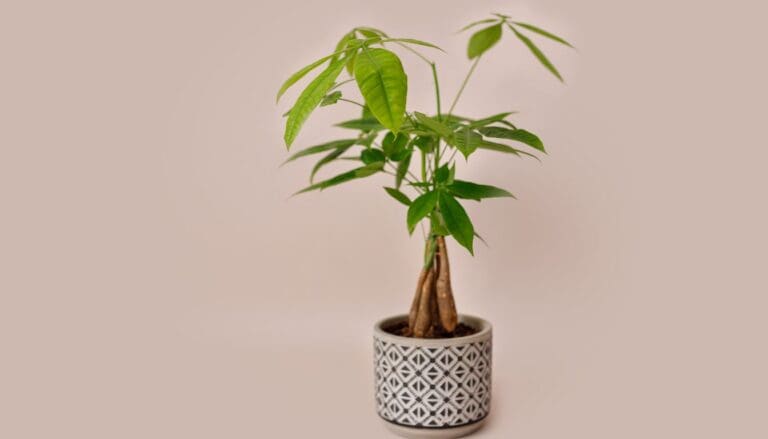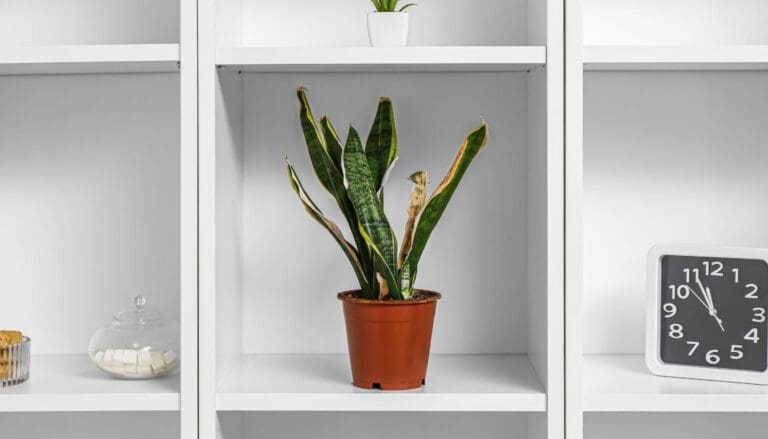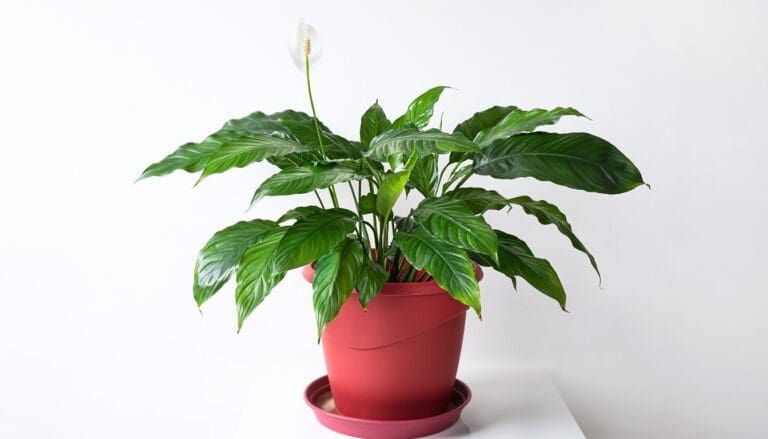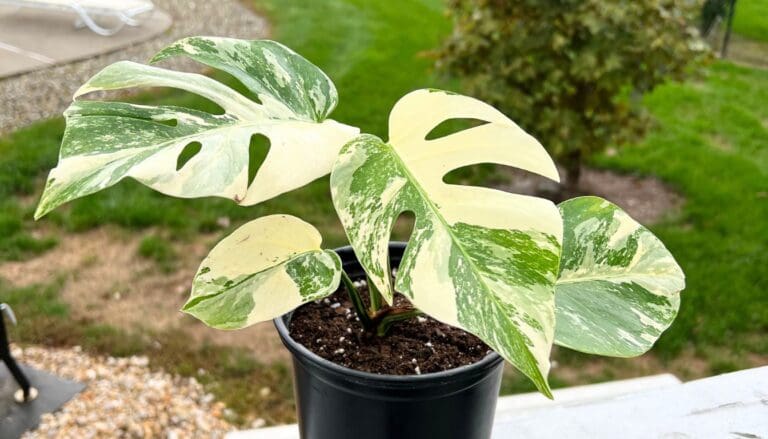Why Are My Calathea Leaves Sticky? (Causes+How To Fix)
Calatheas are loved for their beautiful leaves. But, a problem that growers complain about is sticky Calathea leaves. Sticky leaves in Calathea might give a feeling of both disgust and frustration. It is needful to get rid of sticky leaves by cleaning them and fixing the cause behind them.
But why are your calathea leaves sticky? Let’s find out.
The primary cause of sticky leaves in Calathea is pest infestation. The pests suck out all the sap from the plant and secrete honeydew on the leaves, making the leaves sticky. Other than pests, Calathea leaves also secrete sap through guttation, due to which the leaves remain sticky.
If you find sticky leaves on your Calathea but don’t know the reason behind them, reading this article will let you understand the reasons behind sticky Calathea leaves.

Please note: Simplify Plants is reader-supported. Some links in the post are affiliate links and I get a commission from purchases made through links in the post.
Why is my Calathea sticky?
The primary cause behind sticky Calathea leaves is pest infestation. The one widespread pest found in Calathea is spider mites. They feed on the leaves and create sticky web-like structures on the edges of the leaves, thus making the leaves sticky.
Other bugs like aphids, mealybugs, and scales infect the Calathea leaves and secrete honeydew on the leaves and underneath, making them sticky.
The leaves feel sticky after their secretion because this honeydew is their poop. It is sticky because of the sugar they suck out of the plants.
You will sometimes get to feel only stickiness in the leaves but no bugs or pest infestation. Calathea sometimes secretes sap which can result in sticky Calathea leaves. This is released through guttation.
Along with the excess water, the excess salt and minerals also get released, thus making the leaves sticky.
In such sticky conditions, ants and other insects will easily get attracted to your plant. So, it is essential to clean the leaves as soon as possible to prevent any ant or insect infestation.
Now, let’s elaborate on the causes behind sticky Calathea leaves.
Stickiness due to secretion of honeydew
Honeydew is a sticky substance released by the bugs like aphids, mealybugs, and scales on the surface or underside of the leaves. They suck out all the saps and juices from the leaves, which are the plant’s sugar.
After feeding and digesting, they release these sugar as honeydew through poop. This stays on the leaves, thus making the leaves sticky.
If you don’t clean them, the honeydew content will keep increasing, and at some point, they will drip down to the other lower parts.
The ants can easily reach the lower parts, feed on the honeydew, and if the place feels ideal, they will stay there.
Stickiness due to spider mites
Spider mites are common pests found in Calatheas than any other pests. They stay underneath the leaves, feed on the plant, and even create sticky web structures on the leaf’s tips and edges.
The spider mites make these sticky webs to protect themselves and their eggs from other hunters. These webs will also help them to move from one plant to another. In this way, they will keep increasing their colonies.
Generally, the lower side of the leaves will feel sticky due to those webs made by the mites. In the beginning, the webs would not be visible to you.
But, when they are visible to you, it means the infestation has started a long time back, and now the problem is severe.
Calatheas secrete sap
Sometimes, Calatheas secrete saps through guttation. Guttation occurs when the plants take up much more water than they can handle. They release extra water through guttation during the night or early morning.
Through guttation, the leaves will also release saps which will, in turn, make the leaves feel sticky.
Usually, the sap crystal is an indication that bugs have infected your plant because they release honeydew.
But, when you find only sap crystals on the top or bottom of the leaves but no signs of bug infestation, it is the plant releasing these saps.
In this case, too, cleaning is essential. Whatever may be the reason behind sticky Calathea leaves, cleaning is vital to stop any further insect or ant infestation.
How to remove the stickiness from the Calathea leaves?
It is essential to get rid of this stickiness from the Calathea leaves. Keeping the leaves clean will prevent further ants or insect infestation. Once ants get infected, they can eat up the whole plant.
Scales
These hard armored bugs will always try finding a juicy spot and immediately feed on it. They are tough to remove by mere use of any spray. Their hard shells protect them from all sorts of insecticides.
They need to be removed manually by wiping off the leaves. Damp the cloth by soaking it in warm water or wet the scales with a cotton ball by rubbing alcohol.
However, if scales too much infest the plant, you might have to discard them. But once you fix the problem early and take control of the situation, you won’t have to discard the plant.
For removing them, you can also consider trying horticulture oils and mild insecticidal soaps. This will create a layer over their protective armors and cut off their oxygen supply, due to which they will suffocate and die.
If you just want to remove them and not kill them, you can weaken their outer shells:
Make a solution of 1 tbsp dishwashing soap and 1-gallon water. Take a cotton ball, immerse it in the solution and rub it on the leaf surface and underside. After some time, clean the plant.
Damp a cotton ball, rubbing alcohol, and use it over the scale bodies. Avoid the leaves. Place a paper under the leaves so that the scales can fall on the leaves, and you can discard all of them.
Use tweezers to pick the scales individually.
For prevention, you need to avoid stressing the plant. Damp conditions tend to attract them a lot. Avoid overwatering your plant.
Aphids and Mealybugs

These two are also sap-sucking bugs found in Calatheas. They will suck out all the juices and release them in the form of honeydew. The mealybugs have a white, cottony, wax-like look.
Unlike scales, they don’t have any protective shells or armor on their body.
You can spray neem oil in the plant, especially in the infected area. This will remove them and also help in preventing any further infestation.
You can also use insecticidal soaps to remove them. Make a solution with water and spray it on the infected area. After some hours, wash it off.
You can also release some natural predators. The ladybugs love the aphids. They will enjoy feeding on all the aphids, and your plant will be free from all of them.
If the infestation is severe, you have to use chemical pesticides to kill them. Be careful while using them and read all the instructions attentively.
Spider mites
Another bug found in Calatheas is the spider mite. It is mainly these bugs and their webs due to which the Calathea leaves become sticky all over the top and bottom.
Primarily, the lower side of the leaves is sticky than any other area because that is where they stay and build up their family or community or whatever you wish to call.
At first, you should isolate the plant and remove the affected leaves. This will stop further spreading. Now time to remove the bugs from the particular plant.
To remove spider mites, use certain methods:
You can make a solution of isopropyl alcohol, commonly known as rubbing alcohol, with water. Make the solution with a ratio of 1:4. Use filtered water.
Make a solution with one tablespoon dish wash soap and 1 liter of warm water. Use harsh, chemical-free products like degreasers. It contains peppermint that can deter pests.
3% hydrogen peroxide concentration will also help remove spider mites from Calathea.
Neem oil is one of the best and efficient organic pesticides that will help repel both pests and fungus. Mix 1/3 teaspoon of soap, 1-liter water (to stir the oil well), and one teaspoon neem.
Take any solution, whichever you prefer, mix the solution very well and transfer it to a spray bottle. Now, spray the solution in the Calatheas thoroughly, from top to bottom, especially on the infested areas.
After some time:
- Wipe the plant with a cloth, cotton pad, brushes, or paper towel.
- Dip anyone into the used solution and clean the foliage.
- Be gentle while doing it.
This will kill the spider mites and decrease their population and avoid any further appearance.
If you have used neem oil in Calatheas, keep your plant away from the reach of direct sunlight. Let them have bright, filtered sunlight.
Besides being organic and harm-free, neem is also a potent pesticide. It can increase the chances of sunburns if exposed to direct sun.
Also read: Do Calathes Attract Bugs? (Common Pest+Solution)
Preventing guttation
Guttation is a very natural process in plants. This is their way of keeping the plant healthy by releasing excess water.
But, along with water, the Calatheas tend to secrete the saps with this water, for which they remain sticky.
Stickiness is due to this sap secretion through guttation when you find sticky crystal saps in your Calatheas, but there are no signs of bug or fungus infestation.
You can just clean the leaves to remove the stickiness. But, you can try to reduce guttation. Though guttation is not bad, sometimes, when guttation increases, it becomes necessary to stop them.
To prevent stickiness by guttation:
Watering your Calathea in the evening or at night can increase guttation. Stop watering in such timings. You can water your Calathea in the morning.
Avoid using tap water. As this type of water contains hard minerals, these get released through guttation, thus making the leaves sticky. So, it is better to use distilled or filtered water. Rainwater is also a good option.
Over-fertilization will tend to lose excess water due to excessive salt accumulation. While guttation occurs, these nutrients too will get released and make the plant sticky.
Avoid over-fertilizing Calatheas. Fertilize them only once a month. Also, don’t fertilize them during the winters.
Also read: Why Are My Indoor Plant Leaves Wet? (Dripping water, Guttation & More)
How to clean the sticky leaves?

Honeydew is a sugary substance that will be loved and enjoyed by ants. Cleaning the leaves is essential to stop attracting ants and other insects.
For cleaning the Calathea leaves to remove the stickiness:
- Mix a dishwashing soap with water and dip a cotton ball or cloth into it.
- Mix 1 tablespoon of dish soap with one-quarter warm water. Shake and mix well.
- Just wipe the leaves gently. Carefully handle the leaves, making sure not to hurt or tear them.
- If the dish wash soap is not available, you can use rubbing alcohol to wipe the Calathea leaves.
Final words
Sticky Calathea will not cause any serious problems if they are treated beforehand. But that doesn’t mean they should be left like that. You need to fix it so that stickiness doesn’t increase.
As most pests are responsible for sticky leaves, you can mist the plants with neem oil once a month. This will control infestation and also prevent it.
While using neem oil, you need to keep in mind is not to expose the plant to direct sun as that can scorch the leaves.
Clean the Calathea leaves regularly and avoid the situations which make the leaves sticky. Avoid over-fertilizing, evening or night watering, and tap water to reduce guttation.
With proper care and attention, Calatheas will no longer have any problems.
Observe your plant daily and thoroughly to check whether there are any signs of pests or not. If you find it, fix it quickly so that damage doesn’t increase and is under control.
Source: NCBI, University of Florida, Wikipedia, Growing Indoor Plants with Success, Agriculture, and Natural Resources, University of California, Missouri Botanical Garden.
Recommended Garden Supplies
| Product Image | Our Recommended Gardening Supplies | Check Offers! |
|---|---|---|
Top Top
Top
Top
Top
Top
Top
Top
Top | rePotme Houseplant and Tropical Classic Potting Soil Mix | Check Offer On Amazon |
 Top
Top
Top
Top
Top
Top
Top
Top | Espoma Organic Indoor Plant Food | Check Offer On Amazon |
 Top
Top
Top
Top
Top
Top
Top
Top | GooingTop LED Grow Light 6000K Full Spectrum Clip Plant Growing Lamp | Check Offer On Amazon |
 Top
Top
Top
Top
Top
Top
Top
Top | Soil Moisture Meter | Check Offer On Amazon |
 Top
Top
Top
Top
Top
Top
Top
Top | Govee Hygrometer Thermometer, Bluetooth Enabled! | Check Offer On Amazon |
 Top
Top | LEVOIT Humidifiers for Large Room(Best For Plants) | Check Offer On Amazon |
 Top
Top
Top
Top
Top
Top
Top
Top | Upgraded DIY Automatic Drip Irrigation Kit, 15 Potted Houseplants Support | Check Offer On Amazon |
 Top
Top
Top
Top
Top
Top
Top
Top | Stainless Steel Heavy Duty Gardening Tool Set | Check Offer On Amazon |
 Top
Top
Top
Top
Top
Top
Top
Top | Bonide Insecticidal Soap | Check Offer On Amazon |
 Top
Top
Top
Top
Top
Top
Top
Top | Bonide 32 oz Spray Neem Oil for Organic Gardening | Check Offer On Amazon |
 Top
Top
Top
Top
Top
Top
Top
Top | Garden Safe Fungicide | Check Offer On Amazon |






